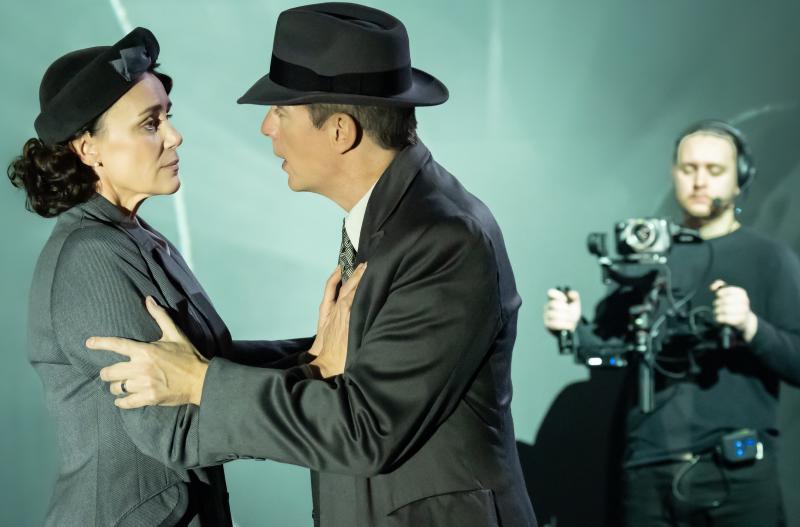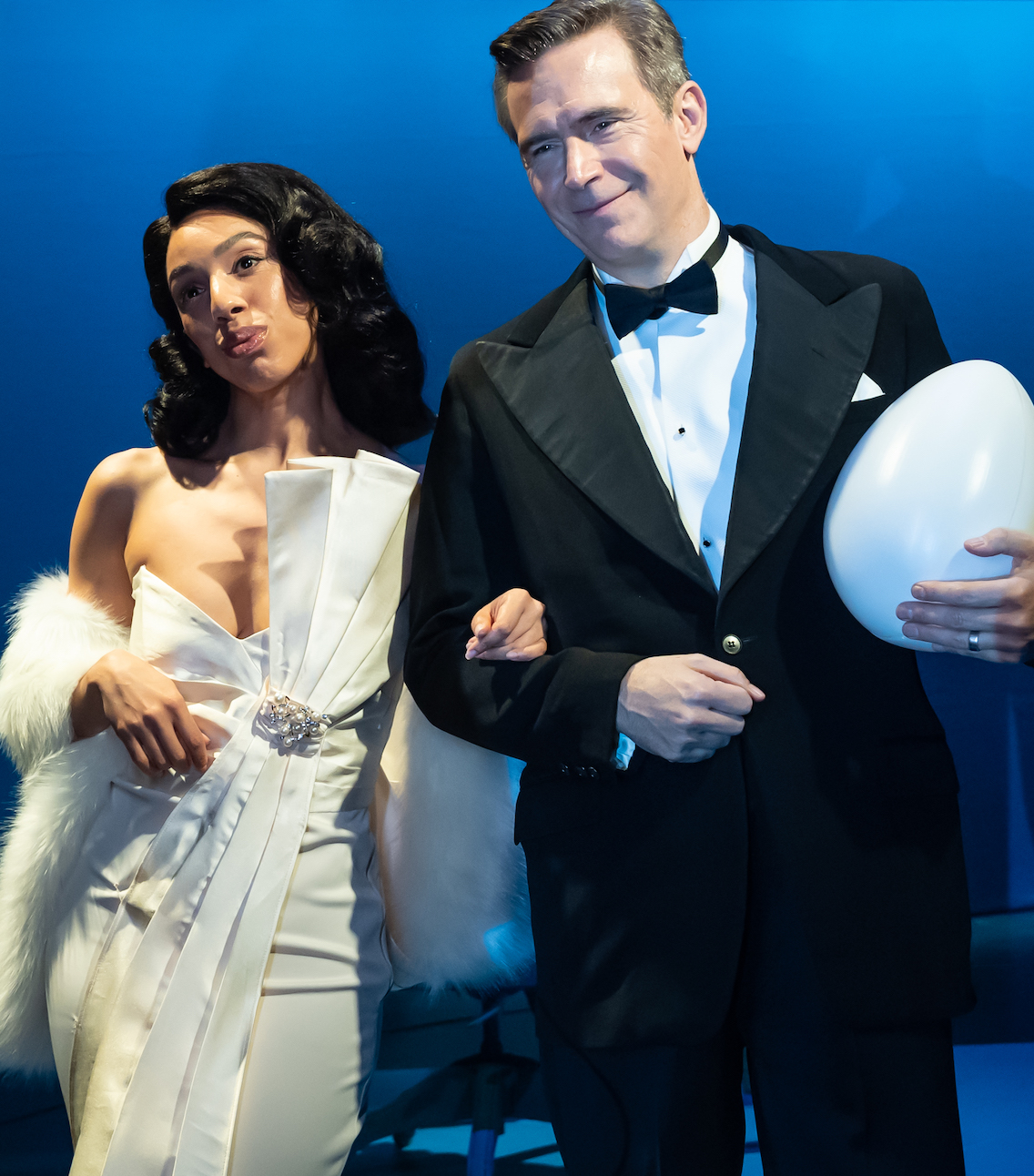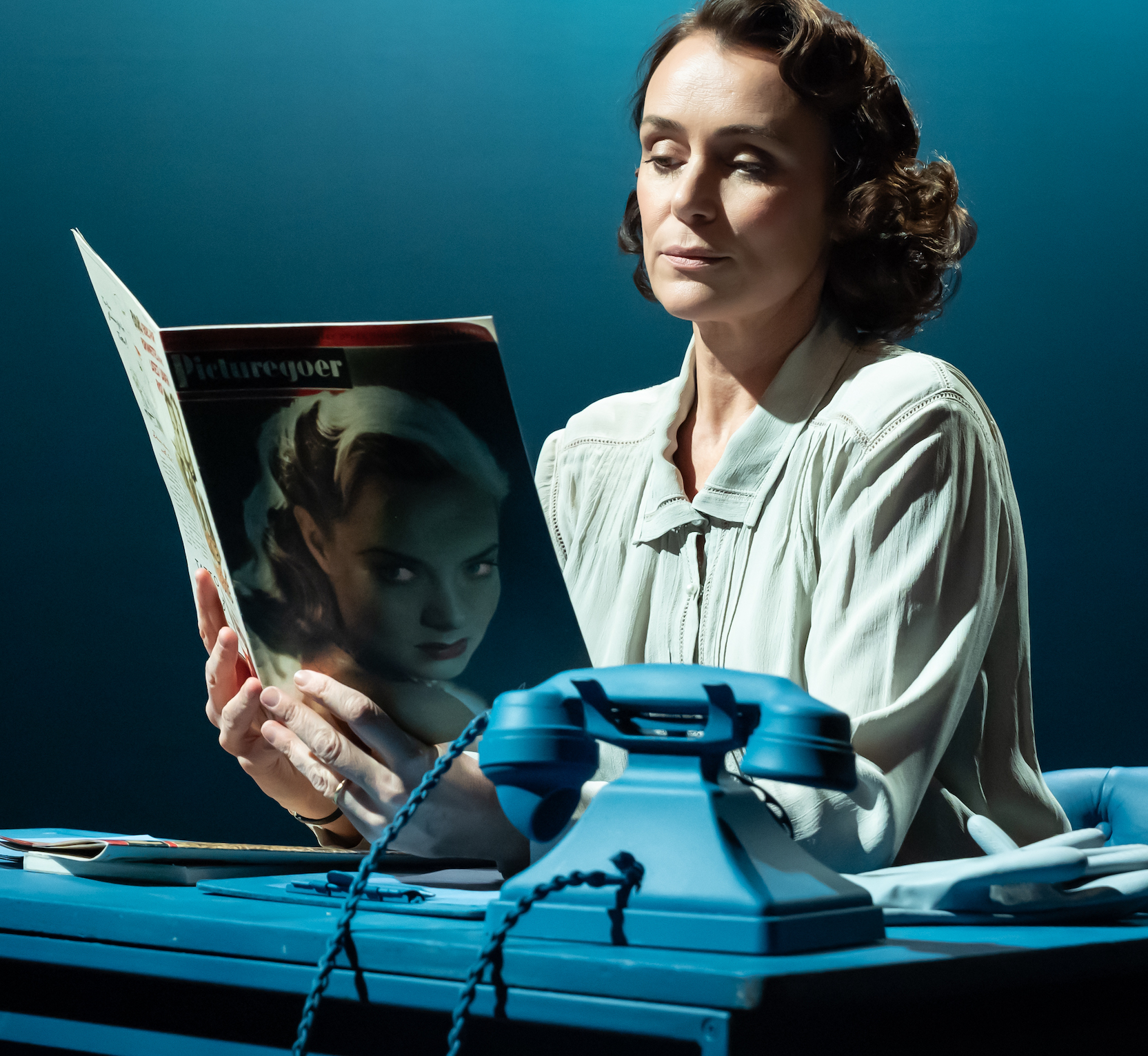The Human Body, Donmar Warehouse review - Keeley Hawes and Jack Davenport excel in an intriguing staging | reviews, news & interviews
The Human Body, Donmar Warehouse review - Keeley Hawes and Jack Davenport excel in an intriguing staging
The Human Body, Donmar Warehouse review - Keeley Hawes and Jack Davenport excel in an intriguing staging
Lucy Kirkwood’s latest mixes the birth of the NHS with a Brief Encounter-ish romance

Keeley Hawes onstage is something to look forward to, so rare are her appearances there.
Kirkwood toys with that 1945 film, and the look and sound of late-1940s British cinema in general, for what is from one angle a romance, from another a plea for the NHS. It’s 1948 and free health care is in the final stages of becoming a reality. Hawes is a businesslike GP in Shropshire, but also an aspiring parliamentary candidate. Mentoring her is a Labour strategist, Helen, one of many roles Siobhan Redmond expertly delivers via a range of wigs and accents (as do Tom Goodman-Hill and Pearl Mackie). Helen’s plan is for Iris to take over a key post that may be about to open up, to play midwife to the NHS’s birth.
Spliced into this plot is Iris’s brief encounter with a handsome stranger on a train (Jack Davenport), who turns out to be, not a Hitchcockian psycho – though Bernard Herrmann-esque music accompanies the early scenes, before the soundtrack goes full Rach2 – but a minor Hollywood star, George Blythe. Suddenly Iris’s marriage to Julian (Goodman-Hill), a ship’s doctor still in serious pain from wounds picked up on the last day of the conflict, seems less tolerable than before. It is a sexless union, despite Iris’s coaxing. Julian, in his misery, finds her body repellent. Just as bad is that he has publicly come out against the NHS and, like 70% of his fellow doctors, is not willing to be a servant of the state.
 The two strands of the plot proceed in parallel for much of the first half, the couple drawing closer together. She is not a moviegoer, but reads old movie magazines from her waiting room and learns that George is married to an American actress (Pearl Mackie, pictured right with Davenport). But her body for once rules her mind. Then the two plot strands intersect, Iris’s life is upended and George too suffers a sudden reversal of fortune.
The two strands of the plot proceed in parallel for much of the first half, the couple drawing closer together. She is not a moviegoer, but reads old movie magazines from her waiting room and learns that George is married to an American actress (Pearl Mackie, pictured right with Davenport). But her body for once rules her mind. Then the two plot strands intersect, Iris’s life is upended and George too suffers a sudden reversal of fortune.
This isn’t a revamp of Brief Encounter, it’s a routing of the premise on which it was based: that nice gels don’t stray, and certainly don’t aim for high-level jobs in quasi-socialist institutions. Which is why the staging that directors Michael Longhurst and Ann Yee have chosen is crucial. The screen-Iris on the back wall isn’t a modish gimmick – she reminds us of the way women of Iris’s generation were asked to see themselves: fragrant, decent, self-sacrificing mothers and wives, there to soothe and nourish. But they have emerged from their male roles in the war with new ambitions, happily multitasking, much as we see Iris being depicted in the first scene while making a Pathe newsreel item to promote the new health service. Hawes is especially perfect at playacting this newsreel role, her slightly dreamy expression redolent of feminine grace, but with a hint of steel to show she’s a thorough professional too.
The “real life” onstage is a fiction all its own. Everything in it except the humans is matte blue, from the furniture and telephones to the kitchen gadgets and cigarettes. The characters mostly wear shades of grey or dull pastels, a palette that suggests a lacklustre world not back to its old self (the end of certain kinds of rationing is years away). The look draws attention to its own theatricality, which is underlined further by the constant presence of a squad of stage hands in black who hand Hawes her props and follow her around with a camera so as to capture close up the impact of her relationship with George. Outside of that intimacy, a serious social development is taking place, which is incompatible with it. Iris will have to choose.
 Hawes does her best to carry things over the line, but the resolution of the plot seems a bit forced, Kirkwood resolving matters for her leading lady with a slightly implausible twist. But the final moment of the play sends us home happy.
Hawes does her best to carry things over the line, but the resolution of the plot seems a bit forced, Kirkwood resolving matters for her leading lady with a slightly implausible twist. But the final moment of the play sends us home happy.
Hawes is a treat to watch, a wholly natural actress, even with a camera right in her face, who can suggest all the emotions bubbling under the surface of her motionless exterior – a typical late-1940s woman with hair ending in iron curls under a drab grey hat, feet in sensible grey shoes, body encased in an unflattering skirt-suit. Around George, she lights up, flirts and matches his acid wit with her own teasing humour.
Davenport is suitably droll as the amoral charmer who has sat out the war in LA and claims he has no political allegiances, doesn’t vote and doesn’t care. He willingly describes himself as “a shit”, though does cads and bounders too, he quips to Iris. But he makes you suspect George is a vulnerable man beneath this witty veneer, his comic timing too perfect to be natural. Somehow he and Hawes make their chalk and cheese relationship compelling.
By the end, the play does share a key feature with Brief Encounter, in that its heroine has similarly come through a storm in her personal life – but, unlike Celia Johnson, she has taken a bold step forward.
more Theatre
 Testmatch, Orange Tree Theatre review - Raj rage, old and new, flares in cricket dramedy
Winning performances cannot overcome a scattergun approach to a ragbag of issues
Testmatch, Orange Tree Theatre review - Raj rage, old and new, flares in cricket dramedy
Winning performances cannot overcome a scattergun approach to a ragbag of issues
 Banging Denmark, Finborough Theatre review - lively but confusing comedy of modern manners
Superb cast deliver Van Badham's anti-incel barbs and feminist wit with gusto
Banging Denmark, Finborough Theatre review - lively but confusing comedy of modern manners
Superb cast deliver Van Badham's anti-incel barbs and feminist wit with gusto
 London Tide, National Theatre review - haunting moody river blues
New play-with-songs version of Dickens’s 'Our Mutual Friend' is a panoramic Victori-noir
London Tide, National Theatre review - haunting moody river blues
New play-with-songs version of Dickens’s 'Our Mutual Friend' is a panoramic Victori-noir
 Machinal, The Old Vic review - note-perfect pity and terror
Sophie Treadwell's 1928 hard hitter gets full musical and choreographic treatment
Machinal, The Old Vic review - note-perfect pity and terror
Sophie Treadwell's 1928 hard hitter gets full musical and choreographic treatment
 An Actor Convalescing in Devon, Hampstead Theatre review - old school actor tells old school stories
Fact emerges skilfully repackaged as fiction in an affecting solo show by Richard Nelson
An Actor Convalescing in Devon, Hampstead Theatre review - old school actor tells old school stories
Fact emerges skilfully repackaged as fiction in an affecting solo show by Richard Nelson
 The Comeuppance, Almeida Theatre review - remembering high-school high jinks
Latest from American penman Branden Jacobs-Jenkins is less than the sum of its parts
The Comeuppance, Almeida Theatre review - remembering high-school high jinks
Latest from American penman Branden Jacobs-Jenkins is less than the sum of its parts
 Richard, My Richard, Theatre Royal Bury St Edmund's review - too much history, not enough drama
Philippa Gregory’s first play tries to exonerate Richard III, with mixed results
Richard, My Richard, Theatre Royal Bury St Edmund's review - too much history, not enough drama
Philippa Gregory’s first play tries to exonerate Richard III, with mixed results
 Player Kings, Noel Coward Theatre review - inventive showcase for a peerless theatrical knight
Ian McKellen's Falstaff thrives in Robert Icke's entertaining remix of the Henry IV plays
Player Kings, Noel Coward Theatre review - inventive showcase for a peerless theatrical knight
Ian McKellen's Falstaff thrives in Robert Icke's entertaining remix of the Henry IV plays
 Cassie and the Lights, Southwark Playhouse review - powerful, affecting, beautifully acted tale of three sisters in care
Heart-rending chronicle of difficult, damaged lives that refuses to provide glib answers
Cassie and the Lights, Southwark Playhouse review - powerful, affecting, beautifully acted tale of three sisters in care
Heart-rending chronicle of difficult, damaged lives that refuses to provide glib answers
 Gunter, Royal Court review - jolly tale of witchcraft and misogyny
A five-women team spell out a feminist message with humour and strong singing
Gunter, Royal Court review - jolly tale of witchcraft and misogyny
A five-women team spell out a feminist message with humour and strong singing
 First Person: actor Paul Jesson on survival, strength, and the healing potential of art
Olivier Award-winner explains how Richard Nelson came to write a solo play for him
First Person: actor Paul Jesson on survival, strength, and the healing potential of art
Olivier Award-winner explains how Richard Nelson came to write a solo play for him
 Underdog: the Other, Other Brontë, National Theatre review - enjoyably comic if caricatured sibling rivalry
Gemma Whelan discovers a mean streak under Charlotte's respectable bonnet
Underdog: the Other, Other Brontë, National Theatre review - enjoyably comic if caricatured sibling rivalry
Gemma Whelan discovers a mean streak under Charlotte's respectable bonnet

Add comment